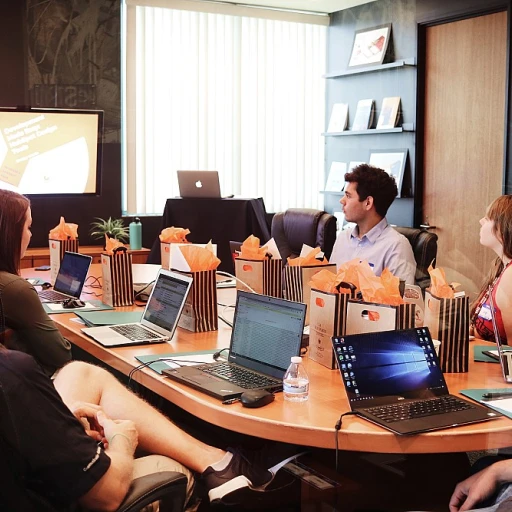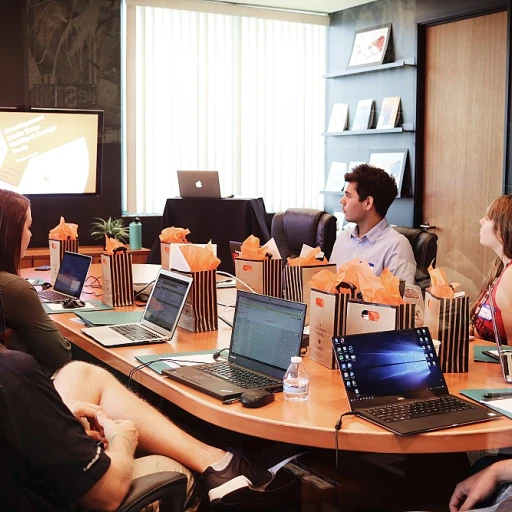
Understanding Workforce Enablement
Unlocking Workforce Potential
In today's dynamic world, workforce enablement stands as a cornerstone in empowering businesses and their employees for success. The term encapsulates the strategic process of providing employees with the necessary resources, tools, and training to enhance productivity and job satisfaction. Organizations that prioritize workforce enablement focus on creating a supportive work environment where employees feel valued and equipped to perform their duties effectively.
Workforce enablement involves more than just offering basic training. It's about fostering an environment of continuous learning and development, where employees can expand their skills and adapt to changing work demands. This approach not only boosts employee engagement but also contributes to better customer service and patient care. Explore how some companies are leading the way in reskilling initiatives.
Organizations that invest in workforce enablement find that it aids in addressing skill gaps by equipping their team for real-time decision-making. Moreover, accessing resources and learning opportunities ensures employees are well-prepared to handle the complexities of modern work. The frontline workforce, in particular, benefits from such enablement initiatives, which in turn enhances overall business productivity and customer satisfaction.
Ultimately, the empowerment of employees through strategic enablement solutions leads to a well-equipped workforce capable of meeting both current and future challenges. Effective enablement fosters a culture of self-improvement and resilience, critical for achieving long-term success and sustainability in today's competitive landscape.
Identifying Skills Gaps
Pinpointing Areas for Skill Enhancement
Understanding the specific areas where skill gaps exist is the cornerstone of any workforce enablement initiative. Identifying these gaps requires a strategic approach, combining both qualitative and quantitative measures. Data-driven insights are crucial here; they allow organizations to tailor reskilling programs effectively, ensuring real-time adaptation to evolving business needs.
To pinpoint skill deficiencies within the workforce, consider the following steps:
- Conduct Skills Assessments: Regular evaluations help ascertain the current skill levels across different employee roles. This can range from technical capabilities to soft skills, influencing productivity and employee satisfaction.
- Leverage Technology: Advanced tools and platforms facilitate efficient information gathering, modernizing the process of identifying skill gaps. They can streamline the assessment process, offering a comprehensive view of workforce competencies.
- Gather Feedback: Regular feedback from employees provides valuable insights into areas they struggle with, influencing future enablement solutions. Navigate the complexities of feedback effectively in reskilling initiatives.
Employee engagement plays a pivotal role in marking these gaps. When employees feel heard and valued, their willingness to participate in reskilling efforts increases, fostering a learning culture. This collaborative approach not only aids in personal development but also contributes to improved customer service and patient care outcomes through enhanced service quality.
Data utilization should prioritise employee enablement by ensuring equitable access to development opportunities. This can significantly improve customer satisfaction and business outcomes, benefiting both the employees and the organization in the long term.
Strategies for Effective Reskilling
Crafting a Roadmap to Future-Proof Skills
In the realm of reskilling, identifying the right strategies is paramount to ensure the workforce is equipped not just for today, but for a rapidly evolving future. Organizations need to recognize that empowering employees through reskilling isn't merely about providing training. It's about creating a comprehensive enablement strategy that enhances employee satisfaction and engagement. To start, it's essential to pinpoint the specific skills gaps within the organization. Utilizing data and feedback from employee surveys can aid in this process. This data-driven approach enables organizations to design training that is both relevant and efficient, aligning with real-time needs and future goals. When employees feel that their development opportunities are tailored to their needs, they are more likely to engage and contribute positively to the work environment. Deploying effective tools forms the backbone of a solid reskilling strategy. These tools should incorporate adaptive learning technologies that cater to diverse learning styles and pace. The integration of technology, such as learning management systems, provides a platform for continuous learning and access to resources anytime, anywhere, further supporting employee enablement. Employee engagement greatly benefits from a structured training development program. These programs should seamlessly integrate with the daily workflow, especially for the frontline workforce, ensuring no disruption in client services such as customer satisfaction or patient care. Offering development opportunities that promote workforce enablement can significantly enhance productivity and long-term business outcomes. Another vital component is fostering a culture of empowerment within the organization. By aligning with client goals and focusing on mutual success in reskilling, organizations can create enablement initiatives that bolster not just individual growth but collective organizational success. For more depth on this alignment, this link offers valuable insights. Ultimately, strategic reskilling is more than a temporary solution; it is an investment in the organization's future. Organizations that invest in enablement solutions not only retain a competitive edge but also foster an engaged and motivated workforce, ready to tackle the challenges of tomorrow.Overcoming Reskilling Challenges
Addressing the Barriers to Learning and Change
Overcoming the challenges inherent in reskilling initiatives is crucial for empowering employees and achieving workforce enablement. Organizations often face obstacles related to limited resources, technological integration, and promoting continuous learning among the workforce. Understanding these challenges is key to implementing effective reskilling solutions. Firstly, one of the primary hurdles organizations encounter is the allocation of adequate resources. Both financial and logistical resources are essential for successful training development. Companies must evaluate their existing infrastructure and identify gaps in support and tools to facilitate employee learning and growth. When it comes to technology, ensuring seamless integration into the work environment is pivotal. Employees need access resources like modernized systems and digital tools which enable real time decision making and boost productivity. Adapting to new technology can be daunting for some workers, necessitating focused training on how these tools enhance job performance and customer satisfaction. Moreover, fostering an environment conducive to continuous learning is critical. Learning and development strategies should cater to both frontline employees and those within other departments, focusing on driving engagement and long-term employee satisfaction. The frontline workforce, in particular, often faces unique challenges, requiring tailored approaches to maintain their performance and service quality. Lastly, promoting a cultural shift is vital for overcoming resistance to change. Encouraging employees to embrace development opportunities and encouraging cross-departmental collaboration can enhance employee engagement and satisfaction. Leadership plays a significant role in advocating for these enablement initiatives, providing the necessary support and guidance for the entire organization. By tackling these challenges head-on, businesses can establish a resilient workforce that is better equipped to adapt to evolving industry demands and improve overall organizational performance.The Role of Leadership in Reskilling
Leadership's Influence on Reskilling Success
In the journey of reskilling, leadership plays a pivotal role in shaping the success of workforce enablement initiatives. Effective leaders not only identify skills gaps but also foster an environment where continuous learning and development opportunities are prioritized. This commitment to employee enablement ensures that the workforce remains agile and responsive to the ever-evolving demands of the business landscape.
Creating a Supportive Work Environment
Leaders must cultivate a work environment that encourages employees to embrace new skills and technologies. By providing access to resources and tools necessary for training development, leaders empower employees to take charge of their own learning journeys. This empowerment leads to increased employee satisfaction and engagement, which are crucial for long-term productivity and business success.
Empowering Employees Through Real-Time Decision Making
Leadership should also focus on enabling the frontline workforce to make informed decisions in real time. This involves equipping employees with the necessary data and insights to enhance customer service and patient care. When employees feel supported and trusted to make decisions, it boosts their confidence and contributes to higher levels of customer satisfaction.
Encouraging Continuous Learning and Development
To overcome reskilling challenges, leaders must champion a culture of continuous learning. This involves not only providing development opportunities but also recognizing and rewarding efforts in skill acquisition. By doing so, organizations can ensure that their employees remain competitive and capable of meeting the demands of their roles.
In conclusion, the role of leadership in reskilling is multifaceted, involving the creation of a supportive work environment, empowering employees, and fostering a culture of continuous learning. By prioritizing these elements, organizations can enhance workforce enablement and drive business success.
Measuring the Impact of Reskilling
Evaluating the Success of Workforce Development Programs
To truly empower employees through reskilling, organizations must measure the impact of their efforts on workforce enablement and overall business outcomes. Employing a robust framework for monitoring and assessment ensures that training development aligns with company goals and meets employee expectations. Start by analyzing data to evaluate whether employees have gained the intended skills and how these skills are being applied in real time within the work environment. This requires leveraging workforce enablement tools to track progress and productivity improvements. Organizations can collect and utilize data on workplace engagement, employee satisfaction, and customer service performance to inform decision making. Some metrics to consider include:- Employee Engagement Levels: Determine if employees feel more engaged and empowered at work. Higher engagement often correlates with increased productivity and better service delivery.
- Customer Satisfaction Scores: Monitor improvements in customer experiences as the upgrading of employee skills should enhance service quality.
- Frontline Workforce Efficiency: Assess whether reskilled employees contribute to more efficient patient care or customer solutions, thereby enhancing service delivery.













